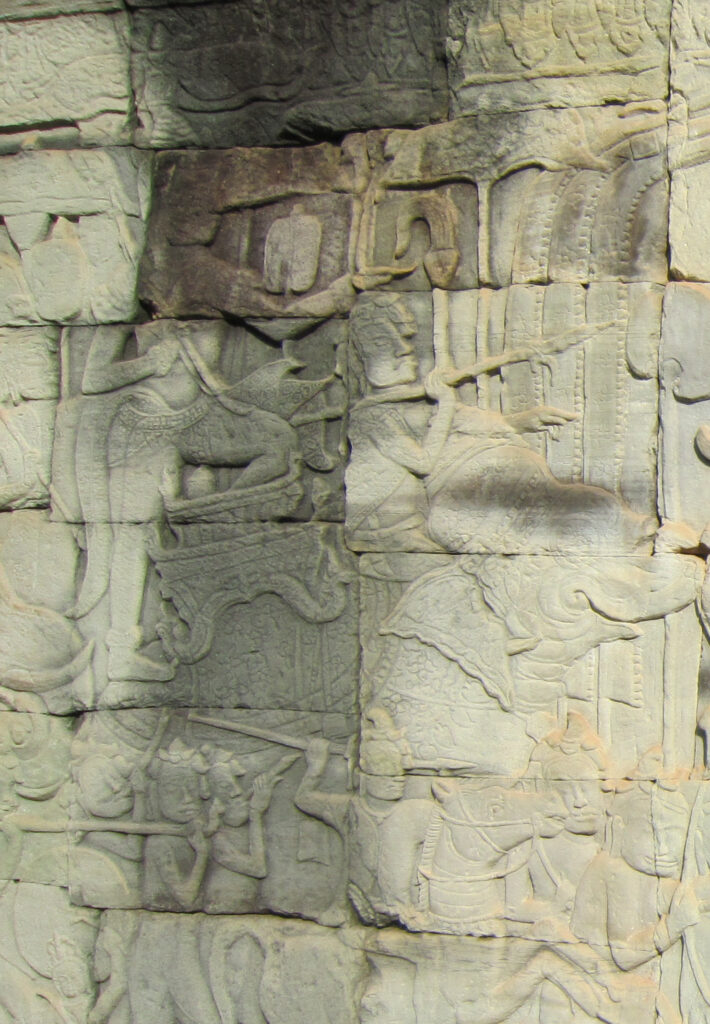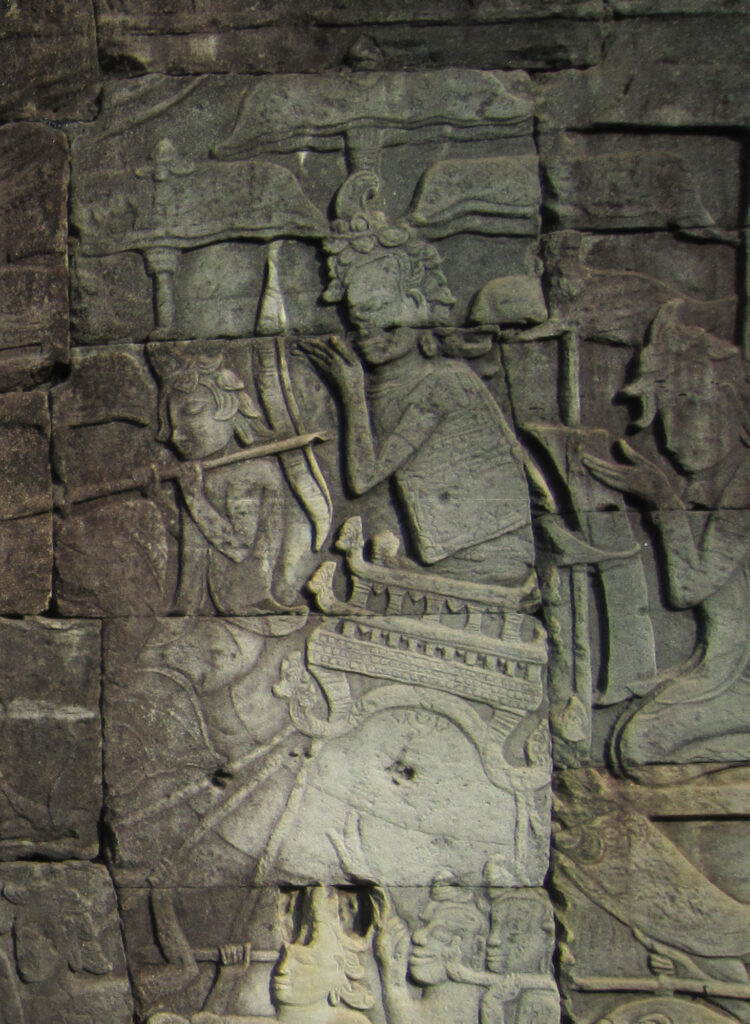ប្រាសាទបាយ័នសាងសង់នៅស.វទី១២ ក្នុងរាជ្យព្រះបាទជ័យវម៌្មនទី៧។ ការសិក្សាបកស្រាយចម្លាក់តាមថែវនៅប្រាសាទបាយ័នមានជាហូរហែរហូតមកដល់បច្ចុប្បន្ន។ កាលណាយើងទៅប្រាសាទបាយ័ន មុននឹងឡើងដល់ក្តីកណ្តាលប្រាសាទ គេត្រូវឆ្លងកាត់ថែវមានចម្លាក់២សិន។ ដូចយើងដឹងទូទៅ ថែវទី១និយាយពីសង្គ្រាម ព្រឹត្តិការណ៍ប្រវត្តិសាស្ត្រ និងបង្ហាញទិដ្ឋភាពទូទៅនៃជីវភាពមនុស្ស។ ដល់ថែវទី២និយាយច្រើនទាក់ទងនឹងកិច្ចពិធីសាសនា និងអានុភាពរបស់ទេពសំខាន់ៗ។ ថែវនេះទាក់ចិត្តអ្នកស្រាវជ្រាវជាតិ និងអន្តរជាតិមិនតិចឡើយ។
គេដឹងជាទូទៅថា ថែវខាងលិចនិយាយជាពិសេសអំពីភាពអស្ចារ្យនានារបស់ព្រះនារាយណ៍មានដូចជា រឿងកូរសមុទ្រទឹកដោះ និងការប្រកួតធ្នូជាដើម។ អត្ថបទនេះនឹងយកចម្លាក់នៅថែវខាងលិចជ្រុងខាងត្បូងមកពិនិត្យបន្ថែម ដោយយោងទៅលើការស្រាវជ្រាវមុនៗ និងយកព័ត៌មានពីសិលាចារឹកខ្លះៗដែលចារក្នុងសម័យកាលដូចគ្នាមកពិចារណា។ ផ្ទាំងចម្លាក់នេះបង្ហាញពីកងទ័ពខ្មែរធ្វើដំណើរពីឆ្វេងទៅស្តាំឆ្ពោះទៅមុខដោយមានទ័ពចាម្បមួយក្រុមនៅជួរមុខ ឯក្បួនទ័ពចាម្បដើរពីខាងស្តាំមកខាងឆ្វេង។ នៅកណ្តាលចំណោមពលទ័ពទាំង២គឺ រូបព្រះនារាយណ៍គង់លើគ្រុឌសំកាងស្លាប ហើយបែរព្រះភក្ត្រទល់ទ័ពចាម្បក្នុងកាយវិការត្រៀមប្រយុទ្ធ។ នៅខាងក្រោយព្រះនារាយណ៍មានទ័ពខ្មែរលាយនឹងទ័ពចាម្បសម្រុកទៅមុខ។ ចំណែកមេទ័ពចាម្បដឹកនាំមុខគេមកតទល់នឹងទ័ពខ្មែរ កាលបើជិតដល់ព្រះនារាយណ៍ក៏ស្រាប់តែលើកដៃបង្គំប្រណមគោរពព្រះចេស្តាព្រះនារាយណ៍ដែលកំពុងគង់លើគ្រុឌសំកាំងនៅស្លាបខាងមុខទៅវិញ។


ករណីខាងលើនេះ ដាំ ទិត្យាវ័ណ្យ ពន្យល់ថា ចម្លាក់នេះបង្ហាញពីទ័ពខ្មែរចេញច្បាំងជាមួយចាម្បដែលមានកិច្ច «អន្តរាគមន៍» ពីព្រះនារាយណ៍ ហើយថែមទាំងបាននិយាយច្បាស់ៗថា អ្នកដែលគង់លើខ្នងដំរីនាំមុខគេនោះ គឺជាព្រះបាទជ័យវម៌្មនទី៧។ លោក Vittorio យល់ដូចគ្នាដែរថា ចម្លាក់ត្រង់នេះ គឺកងទ័ពខ្មែរ និងចាម្បកំពុងប្រឈមមុខដាក់គ្នាស្រាប់តែផុសរូបព្រះនារាយណ៍គង់លើគ្រុឌចំកណ្តាលទី ដើម្បីកម្លាចកម្លាំងទ័ព ចាម្ប។ ត្បិតកាយវិការរបស់កងទ័ពចាម្បបង្ហាញច្បាស់ណាស់ថា ពួកគេកំពុងឱនលំទោនវន្ទាចំពោះមុខព្រះនារាយណ៍ ខុសពីកងទ័ពខ្មែរដែលនៅពីក្រោយព្រះនារាយណ៍ហាក់ដូចកំពុងព្យាយាមវាយសម្រុកទៅមុខ។
នៅសម័យបុរាណ ការប្រដូចព្រះមហាក្សត្រទៅនឹងទេពសំខាន់ៗ ឬការយកទេពកថាមកបញ្ចូលក្នុងការលើកតម្កើងកិត្តិនាមព្រះមហាក្សត្រ គឺជាការពុំចម្លែកឡើយ។ ដើម្បីពិនិត្យបន្ថែមរឿងនេះ សូមយើងក្រឡេកមើលតឹកតាងជាអក្សរវិញ។ សិលាចារឹកប្រាសាទព្រះខ័ន (K.908) ចារក្នុងសម័យកាលដូចគ្នានឹងចម្លាក់ខាងលើបានលើកតម្កើងព្រះបាទជ័យវម៌្មនទី៧ស្មើនឹងព្រះនារាយណ៍ថា «ពន្លឺថាមពលរបស់ព្រះអង្គ (ព្រះបាទជ័យវម៌្មនទី៧) ភ្លឺដូចអាវុធរបស់ព្រះនារាយណ៍បញ្ឆេះទ័ពសត្រូវដូចភ្លើងអៅវ៌ដែលឆេះលឿនដូចភ្លើងឆេះព្រៃ។ ព្រះអង្គមានពន្លឺដូចព្រះចន្ទ្ររះពេលយប់ ឯសត្រូវប្រៀបដូចជាផ្កាឈូកក្រពុំពេលយប់លំឱនកាយចំពោះព្រះភក្ត្រព្រះអង្គ»។ ត្រង់នេះគេប្រៀបប្រដូចសត្រូវទៅនឹងផ្កាឈូក ត្បិតផ្កាឈូកតែងក្រពុំនៅពេលយប់ ដូចសត្រូវទាំងឡាយទ្រោមខ្លួនឱនលំទោនពេលឃើញព្រះអង្គ។ សិលាចារឹកនេះបន្តទៀតថា «គ្រាន់តែឃើញអាវុធដ៏គួរឱ្យខ្លាចរបស់ព្រះអង្គ សត្រូវទាំងប៉ុន្មានបន្ទន់ខ្លួនដូចពស់ទម្លាក់អាវុធចុះ ហើយបិទភ្នែក រីឯលំពែងដែលគេចោលទៅមុននោះក៏ធ្លាក់ជ្រុះអស់»។ ដូចយើងដឹងស្រាប់ ក្នុងទេពកថា ពស់ (ឬនាគ) តែងក្លាយជាចំណីរបស់គ្រុឌ។ យើងដឹងទូទៅថា គ្រុឌគឺជាយានជំនិះរបស់ព្រះនារាយណ៍ ហើយក៏តំណាងឱ្យព្រះនារាយណ៍ដែរ។ បំណងធំ គឺប្រៀបសត្រូវទៅនឹងពស់ដែលតែងខ្លបខ្លាចគ្រុឌ ដូចសត្រូវទាំងនោះខ្លបខ្លាចតេជះព្រះអង្គដូច្នេះដែរ។ ចម្លាក់ខាងលើ សិល្បករចង់បង្ហាញថា ព្រះនារាយណ៍ និងព្រះមហាក្សត្រមានឫទ្ធិអំណាចដូចគ្នាដែលធ្វើឱ្យសត្រូវខ្លបខ្លាចនៅចំពោះមុខព្រះអង្គ។ ឬនិយាយម្យ៉ាងទៀតថា ទ័ពព្រះអង្គមានព្រះនារាយណ៍ជាបង្អែក ទើបធ្វើឱ្យសង្គ្រាមតែងទទួលជោគជ័យ។ ជារួម ព្រះនារាយណ៍មានតួនាទីពិសេសក្នុងកិច្ចការសង្គ្រាមរបស់ក្សត្រ។ យើងឃើញទេពកថាច្រើនណាស់គឺ ព្រះនារាយណ៍តែងចូលអន្តរាគមន៍ ដើម្បីកម្ចាត់សភាវៈអាក្រក់ ក្នុងន័យរក្សាសណ្តាប់ធ្នាប់លោកទាំងមូល។ ម្យ៉ាងទៀត ការយកទេពកថាព្រះនារាយណ៍មកភ្ជាប់នឹងព្រះមហាក្សត្រក៏ឃើញមានមកដល់បច្ចុប្បន្នដែរ។ បើយើងពិនិត្យលំអិតលើនិមិត្តសញ្ញារបស់អង្គភាពនានានៃក្រសួងការពារជាតិ យើងនឹងឃើញតួអង្គសំខាន់ៗក្នុងទេពកថាអវតារនៃព្រះនារាយណ៍៕
———————-
Naraya Intervention in the Khmer-Cham War on Bayon bas-relief
Bayon Temple was built in the 12th century during the reign of King Jayavarman VII. The sculptures in the wall gallery of the Bayon temple have been studied until this day. The first gallery is about war, and historical events and illustrates an overview of people’s daily life. The second gallery talks a lot about the rituals and powers of the principal deities. This gallery attracts many national and international researchers.
It is well known that Western galleries specifically mention the greatness of Narayan, such as the story of the churning of the sea of milk and the story of competition archery. This article will examine the bas-relief in the west and south corners of the gallery which is based on previous research and information from some of the inscriptions in the same period to be considered. This bas-relief indicates the Khmer army moving from left to right, with a group of Cham soldiers in the front line, and a Cham convoy walking from right to left. In the middle of the two armies is the image of Naraya sitting on a Garuda and facing the Cham army in a ready-to-fight gesture. At the back of Narayan, there was a Khmer army mixed with Cham troops advancing forward. As for, the commander of the Cham army was leading against the Khmer army; however, when they see Naraya sitting on Naga they suddenly raised their hands to respect him.
In the above case, Ms. Dam Tityavan explains that this bas-relief illustrates the Khmer army fighting with Cham, which has “intervention” from Naraya, and also explained clearly that the one who sits on the leading elephant is king Jayavarman VII. Mrittorio also understands that the bas-relief is the Khmer army and Cham facing each other, suddenly appears the image of Naraya sitting on the Garuda to scare the Cham army. However, the gestures of the Cham army clearly show that they are bowing in front of Naraya, unlike the Khmer army behind Naraya seems to be trying to attack forward.
In the past, it was not uncommon for the king to be linked to a major deity, or to include a deity in his promotion reputation of the King. To examine this further, we can find out on the inscription of Preah Khan temple (K.908) inscribed in the same period as the above bas-relief promoted the reputation of Jayavarman VII, equal level to Naraya “The light of his energy (Jayavarman VII) shines like Narayan’s weapon Ignites the enemy army like a fire that burns like wildfire. He shines like the moon at night, and the enemy is like a lotus flower at night, bowing down to his face”. At this point, the enemy is likened to a lotus flower, and the lotus flower blossoms at night, as the enemies bow down when they see the King. The inscription goes on ” Just seeing the terrible weapons of the King, the enemies bowed down like snakes, dropped their weapons and close their eyes, whereas the spears that were thrown fell”. As we all know in the myth, snakes (or dragons) always become the food of Garuda. We generally know that Garuda is Naraya’s vehicle and also represents Naraya. The main intention is like an enemy that is always afraid of the Guruda, just as those enemies are afraid of the Lord. The bas-relief above the artist wants to show that Naraya and the king have the same power that frightens the enemy in front of him. In other words, his army had Naraya as a reference to make the war always successful.
In conclusion, Naraya played a special role in the king’s war affairs. We see a lot of myths that Naraya always intervened to destroy evil to keep the whole world order. On the other hand, the connection of the deity Naraya with the king is still seen today. If we look in detail at the symbols of the Ministry of National Defense, we will see the main characters in the incarnation of Naraya.
អត្ថបទដោយ៖ លោក អ៊ូ គង្គា






